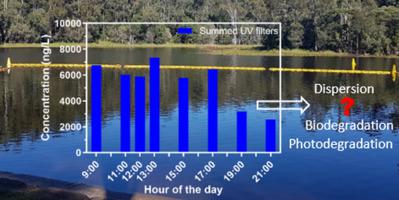Science of the Total Environment ( IF 8.2 ) Pub Date : 2020-09-16 , DOI: 10.1016/j.scitotenv.2020.142373 Elissa O'Malley , Michael S. McLachlan , Jake W. O'Brien , Rory Verhagen , Jochen F. Mueller

|
UV filters present in sunscreen and other cosmetics are directly released into the environment during aquatic recreational activities. The extent to which the wide range of UV filters pose a risk to the environment remains unclear. This study investigated the occurrence and dissipation of selected organic UV filters at a recreational site (Enoggera Reservoir, Queensland, Australia) over 12 hours. Furthermore, different possible degradation processes were investigated in a controlled off-site experiment with surface water exposed to natural light. Half-lives were estimated for ten UV filters. In Enoggera Reservoir, seven UV filters were detected, of which the most prevalent were octocrylene, avobenzone (BMDBM) and enzacamene (4-MBC). Summed concentrations of the seven UV filters ranged from 7330 ng L-1 at 13:00 h to 2550 ng L-1 at 21:00 h. In the degradation experiment, four UV filters showed no significant change over time. The fate of these compounds in the environment is likely to be mainly influenced by dispersion. Half-lives of the remaining UV filters were 6.6 h for amiloxate (IMC), 20 h for benzophenone 1, 23 h for octinoxate (EHMC), 30 h for 3-benzylidene camphor, 34 h for 4-MBC and 140 h for dioxybenzone (BP8). The degree of susceptibility to photodegradation and biodegradation was generally consistent within a structural class. The fate and half-lives of UV filters are variable and should be considered on a per site basis when assessing environmental risk.
中文翻译:

受控实验中淡水休闲水库和宿命中所选紫外线过滤剂的存在
防晒和其他化妆品中存在的紫外线过滤剂会在水上娱乐活动中直接释放到环境中。目前尚不清楚广泛的紫外线过滤剂对环境构成何种风险。这项研究调查了一个休闲场所(澳大利亚昆士兰州的Enoggera水库)在12个小时内选定的有机紫外线过滤剂的发生和消散。此外,在暴露于自然光下的地表水的受控非现场实验中,研究了不同的可能降解过程。估计十个紫外线过滤器的半衰期。在Enoggera水库中,检测到七个紫外线过滤器,其中最普遍的是辛二烯,阿伏苯宗(BMDBM)和enzacamene(4-MBC)。七个紫外线过滤器的总浓度范围为7330 ng L -1在13:00 h时达到2550 ng L -1在21:00 h时。在降解实验中,四个紫外线滤光片没有显示出随时间的变化。这些化合物在环境中的命运可能主要受分散影响。剩余的紫外线滤光片的半衰期为:阿米诺酸酯(IMC)6.6小时,二苯甲酮20小时,辛诺酸酯(EHMC)23小时,3-亚苄基樟脑30小时,4-MBC 34小时,二氧苯甲酮140小时(BP8)。在结构类别内,对光降解和生物降解的敏感性程度通常是一致的。UV滤光片的命运和半衰期是可变的,在评估环境风险时应根据每个站点进行考虑。









































 京公网安备 11010802027423号
京公网安备 11010802027423号